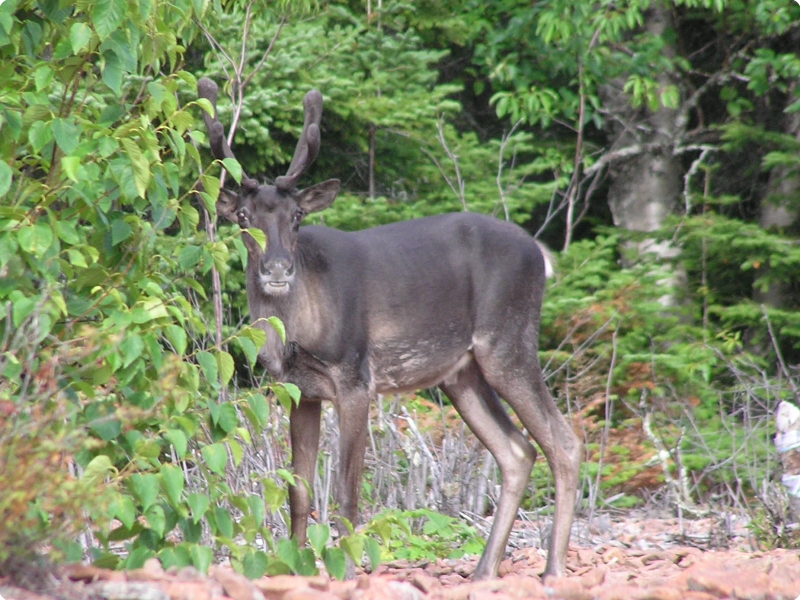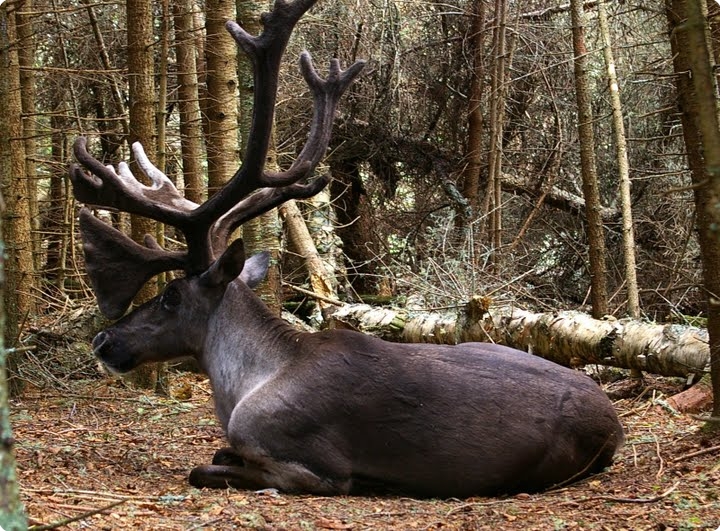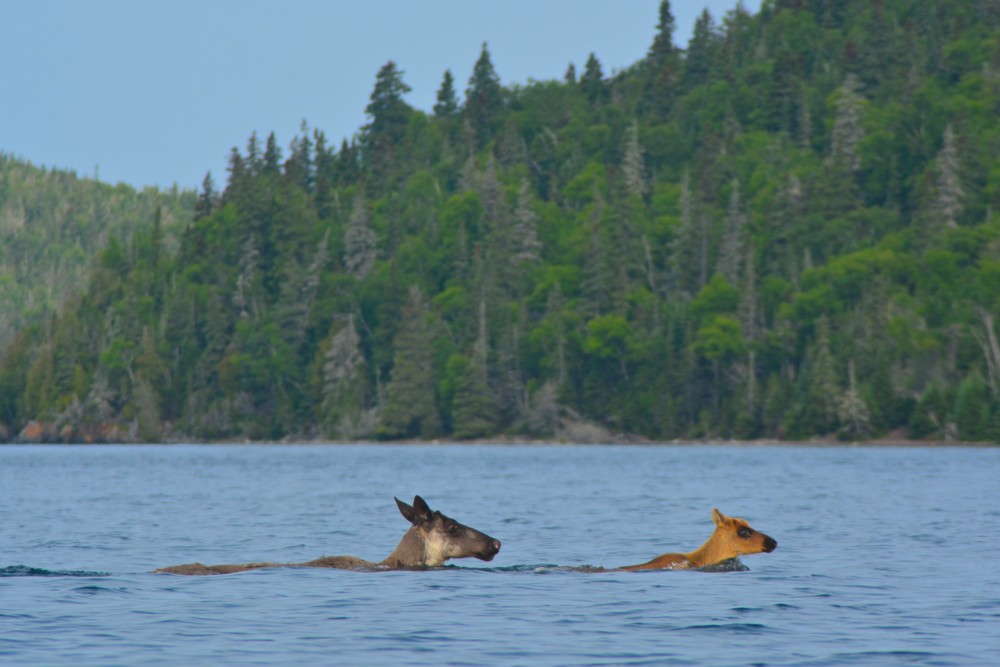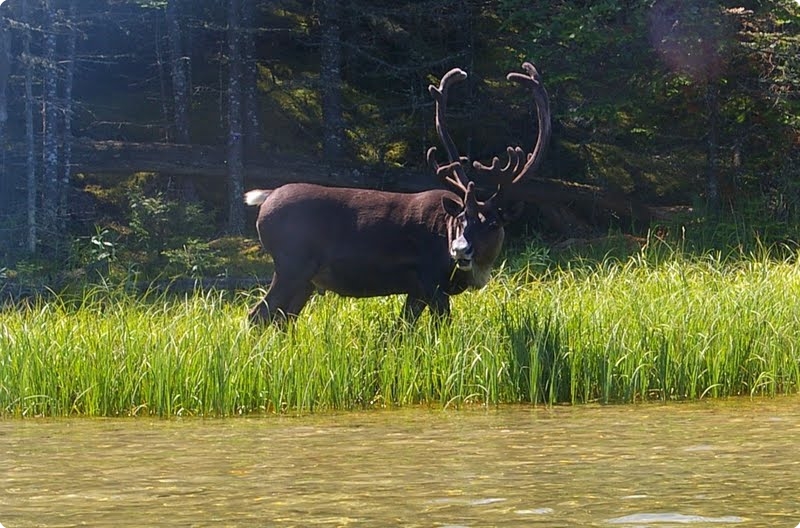This article is about the conservation and restoration of the Lake Superior caribou. These caribou are one of several isolated pockets of woodland caribou along the southern edge of their range in Canada that are in immediate danger of being lost.
The Lake Superior Caribou

Deep History – Woodland caribou spent the last glaciation in the Appalachian Mountains of the eastern United States. As the ice receded, the caribou spread through the forest all along the south edge of the ice. Caribou returned to the Lake Superior area about the same time people arrived. So for about the next 10,000 years caribou provided for and co-existed with the people in this area.
European Settlement – Things began to change about 200 years ago with European settlement. More caribou were shot to feed an increasing population. Caribou habitat was also lost to agriculture, settlements, railroads, roads, pipelines, electrical transmission corridors, and mines. The largest habitat loss was from logging which focused on old conifer forests, often with tree and ground lichens that are the classic winter food of caribou. These old conifer forests were replaced by young forests with a higher component of deciduous shrubs favoured by moose. The increase in moose in these regenerating forests resulted in an increase in wolves. The smaller and sparser caribou were simply unable to withstand this increase in predation – and they steadily declined. By 1980 caribou were gone from the south, west, and east shores of Lake Superior and almost all the off shore islands. There were only scattered caribou on the mainland along the northeast part of the lake, and they were isolated from the main caribou range to the north. Of the islands in Lake Superior, which all had caribou at one time, they remained only on the Slate Islands south of Terrace Bay.

First Restorations – In the early 1900s, 6 caribou were moved from Newfoundland to Caribou Island to restore the population there. In the 1980s, caribou from the Slate Islands were moved to Michipicoten Island and to the off-shore islands and mainland of Lake Superior Provincial Park on the east side of the lake. These populations persisted from 10 to about 40 years. They could have persisted longer but additional efforts were not made to supplement them or protect them.
Near Extirpation – In the winter of 2014 wolves found their way on the ice to both the Slate Islands and Michipicoten Island. By 2017 they had liminated almost all the caribou from the Slate Islands. Only two adult males were thought to have survived. This is called functional extirpation because the population cannot rebuild from one sex. In 2018 the wolves completely extirpated the caribou from Michipicoten Island. However, a few caribou were rescued at the last minute. By 2014 there were only a very few caribou left on the north shore of Lake Superior. In total there were probably about 1100 Lake Superior caribou in 2014 – mostly on Michipicoten Island. By 2018 there were probably less than 30. This catastrophic decline is one of the characteristics of island biogeography. Relatively small islands like the Slates and Michipicoten are simply not large enough for caribou to space out and evade predation by wolves.

Rescue – In the winter of 2018, 9 caribou (8 adult females and 1 adult male) were moved from Michipicoten Island back to the Slate Islands. They joined the 2 remaining adult males there to hopefully restore that population. Just after that, 6 caribou (4 adult females and 2 adult males) were moved from Michipicoten Island to Caribou Island. They were among the last of the caribou on Michipicoten Island and were intended to form a secure backup population of the Lake Superior caribou that could not be reached by wolves. These are very small founding populations, especially the male component , so inbreeding problems are a worry. However, these last caribou from Michipicoten are also the survivors of an extreme predation event and are therefore likely very fit – both physically and genetically.
Present Status – There are now likely in the mid-30s of caribou on the Slate Islands and about 20 caribou on Caribou Island. The last few aerial surveys of the north shore of Lake Superior have not turned up any caribou. So, after persisting for 10,000 years, they are now likely gone from the mainland along Lake Superior. Although the caribou populations are growing in the two restored island locations, they are not out of danger. The Slate Islands are very susceptible to re-invasion by wolves when ice bridges form to the mainland. Caribou Island is small and very susceptible to over-population and subsequent starvation.

Near Future – Plans are in the works to restore caribou to Michipicoten Island. The island just needs to be free of wolves before caribou can be moved back, and there may still be two wolves there. Biigtigong and Michipicoten First Nations are also interested in restoring caribou to the mainland along Lake Superior in their traditional areas. This would include Pukaskwa National Park and the Conservation Reserve between Pukaskwa and Wawa. Prospects for these mainland restorations are good. Ecosystem conditions are thought to be better now than when the caribou disappeared from these areas.
Pukaskwa National Park has stopped their prescribed burning program in a zone 10 km back from the shore, so habitat should be getting better for caribou rather than moose. Aerial surveys in the park also show moose numbers at a level where caribou should be able to co-exist with predator numbers. However, periodic supplementations of the caribou may be necessary until ecosystem conditions return to being completely self-sustaining for caribou.
Prognosis – Getting caribou back to Michipicoten Island and restoring a viable caribou population on the mainland will greatly increase the security of the Lake Superior caribou. This will reverse the continent wide trend of caribou population decline and range recession in at least this small part of Ontario. It will also begin restoring a species that helped the Indigenous people survive here for thousands of years and that they wish to return the favour to.
What can I do? – You can write Minister David Puccini of the Ontario Ministry of Environment, Conservation and Parks at [email protected] . Ask him to help restore the Lake Superior caribou to Michipicoten Island and their recent range on the mainland.
For more information – Contact www.LakeSuperiorCaribou.ca